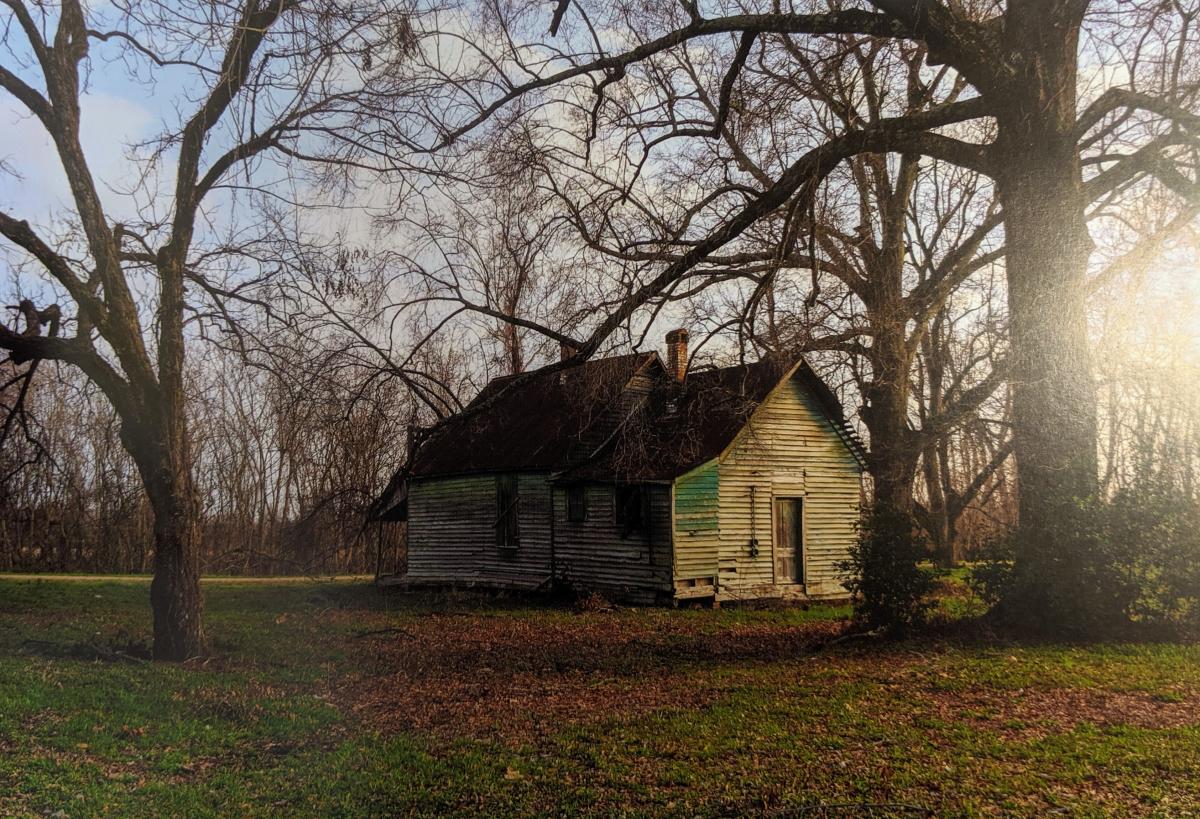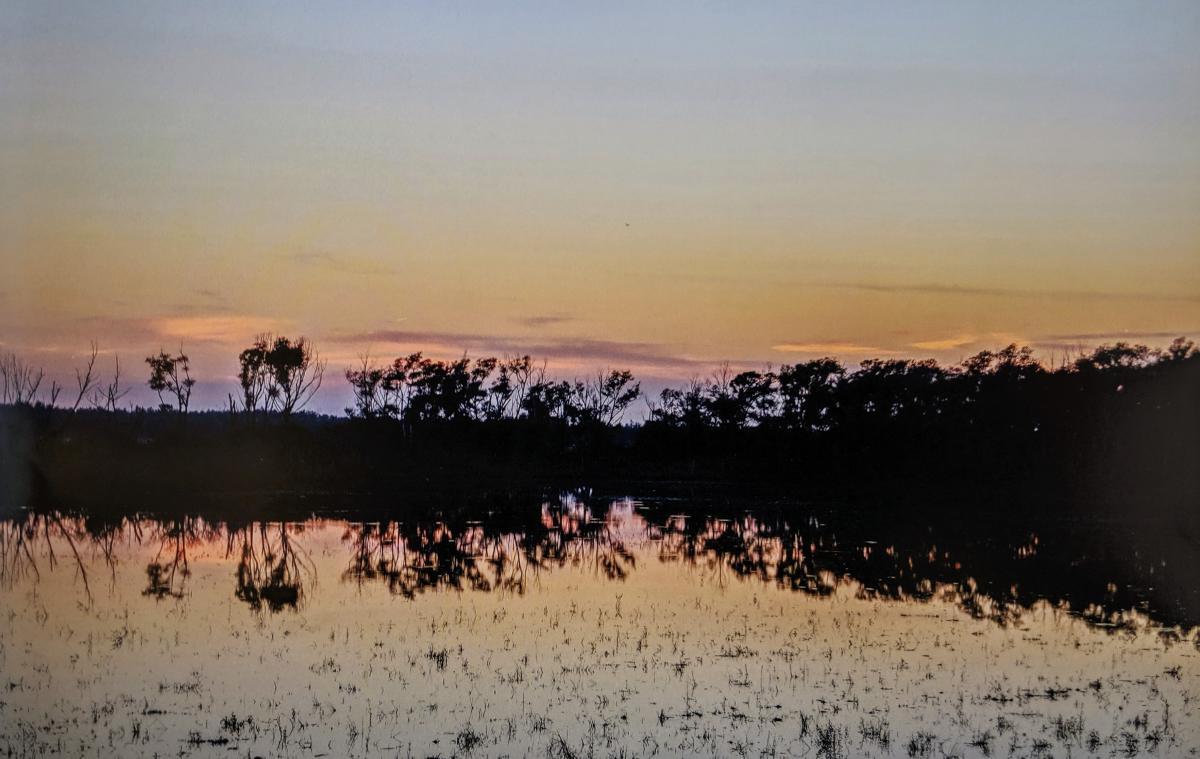
A large-format, mixed genre book of poems by Ann Fisher-Wirth and photographs by Maude Schuyler Clay, Mississippi could be described using the single word light.
This is a project of interconnectedness on every level, bonding place with voice, people with landscape, sensory details with experience, mystery with mundanity, prayer with truth, and of course image with the written word.
The gorgeous photographs here show us the world of Mississippi, yet a printed image can only convey so much: it must be confined by border, by the frame of the shot, and by stillness. It’s two-dimensional, no matter how poignant its subject matter. But the poems here do what ekphrastic work does best: they step into the images and poke around a little, uncovering something that the photograph alone can’t quite show us. One picture is of a mural of Robert Johnson, blues legend who met the devil at the crossroads. Yes, the photograph gives us a keen insight into this character: he’s holding his guitar, he’s surrounded by yellow and blue waves of light, and his expression is of depth and mystery.
But here’s what an image can’t quite do:
in his pocket sprigs of lilac and thyme
sheltered in the crook of his right arm
something you do not see (72)
“Something you do not see” can’t be shown in a visual image, but the poem paired with this photograph can go under that layer, into these pockets, and show us a deeper layer.

Similarly, the poems allow for each image to be imbued with more meaning: a girl on a blanket can tell her story. A tree becomes a person becomes a tree. Through the pairing of poem with photograph, the outside world resonates with new significance. The photograph on Page 83 shows an old house framed by leafless trees. One side of the structure is lit by what I assume is the dawn light, and the rest of the building is shadowed. The sky behind the foreground, however, is bright, a play with light. The poem paired here, however, is a sort of narrative meditation, building a persona through voice and confession: “I’d churn that eggbeater / faster and faster / till my hands got tired let it fall back quiet.” The scene winds forward, and we end in presumably this house, with “all those bugs clamoring up / like love.” This poem uncovers love through a process of decay.
This process of uncovering marks a major difference between the arts of photograph and poetry: for a photographer, the process involves capturing a moment; sure, an image may hint at the passage of time but the medium doesn’t allow for a clear demarcation, at least within a single image. I’m thinking especially of the image on Page 7, of a house captured beyond a body of water. Like the image described above, it’s fall or winter: the trees are stark and there’s a sense of cold. Perhaps this cold is inferred through the use of light: the foreground is the darkest part of this image and the sky moves from pale blue to white. By invoking a sense of season, the image does invoke the passage of time, and of course, showing a rundown structure allows us to consider its past. But we can’t quite grasp the future in the way the poem does. It seems our speaker is directly addressing the water, implying a flood narrative that’s not quite present in the image itself. “oh, go ahead rise up,” our speaker taunts, inferring towards a future that is grim.
I’m so drawn to the end of this poem for both the way it effortlessly ropes in an ecological issue and its resilience. “Don’t you know we’ll get away,” the penultimate line states more than asks. “[D]on’t you know we’ll leave by boat,” the poem ends. Like all the poems in this book, there is no punctuation, allowing for a sense of continuity despite the different voices, images, scenes, etc. This move highlights the interconnectedness of this book, which is itself an ecological move.
The discipline of ecology draws its name from the Greek word oikos, which means “household.” To understand an ecology is to study not just a specific creature but its relation to and interactions with its surroundings. In this way, Mississippi is a practice of true ecology: the focus is not just on the natural world but also on the ways humans interact with the landscape, each other and their inner selves.

Page 87 shows us another photograph concerned with sunlight: a sunset and its reflection on water. Again, the sky and water are lit while the land itself resides in darkness; the trees are silhouetted against the sky in pure black. The poem paired here is of a woman’s domestic experience and the trials of being a mother while keeping the household together. Her partner swoops in to say, “We’ll mess with this shit later,” driving her instead to the lake:
Breathe he tells me
baby breathe
and look at it just look at it
There’s no action to be taken, no work to be done, just the act of breathing—something that we’re always doing, unaware. I love how the light is doing the action here. This feels like both a commentary on ekphrasis; an ars photographia? All photography depends on light. To take a photograph, one must follow light’s path; to write about an image, a poet must follow a path in a different way. In both cases, the artist (or reader or viewer) must just breathe, and look at it. Just look at it.
Stacey Balkun is the author of Eppur Si Muove, Jackalope-Girl Learns to Speak & Lost City Museum. Winner of the 2017 Women's National Book Association Poetry Prize, her work has appeared in Best New Poets, Crab Orchard Review, The Rumpus, and other anthologies & journals. Chapbook Series Editor for Sundress Publications, Stacey holds an MFA from Fresno State and teaches poetry online at The Poetry Barn & The Loft. Find her online at http://www.staceybalkun.com/

